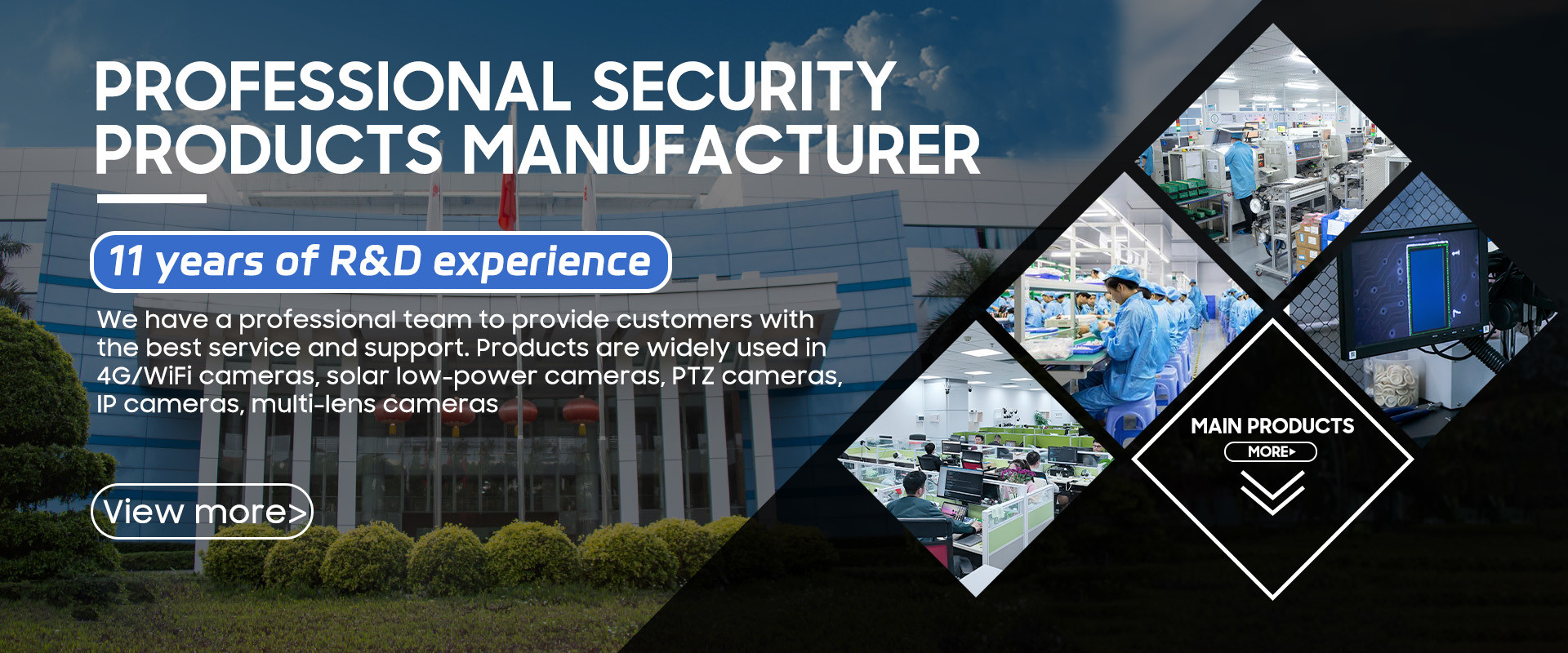Applications for Solar Battery Powered Cameras
2023-01-04
Installing solar powered security cameras is a great way to reduce your energy bills and emissions. Although the solar panels are not removable, they require no routine maintenance. Whether you're looking for a security camera that can reach difficult areas, or you want to be eco-friendly, solar-powered security cameras are a great option.
What is a Solar Powered Camera?Solar-powered security cameras, also commonly known as solar-powered security cameras, use the sun's energy to power compatible surveillance cameras.
How does a Solar Security Camera work?
Solar-powered security cameras use solar panels to harness sunlight and convert it into direct current (DC). An inverter then converts the direct current to alternating current (AC), which can then be used to power the solar monitor.
What happens when it's raining or cloudy? Will a solar powered security camera work?
Most solar powered cameras also come with an alternative or backup power source, usually a rechargeable battery. The solar panels not only power the security cameras, but also charge the batteries. When there is no direct sunlight (at night or in the rain), the solar powered security camera will be powered by a rechargeable battery. The battery will start charging as soon as there is direct sunlight.
Benefits of Solar Security Cameras
The main advantage of solar-powered surveillance cameras is that the solar panels charge the battery-powered cameras, creating a renewable power source. You can choose a wifi version or a 4G version, and these cameras can be used in more difficult-to-access areas of the home, such as rooftops. For places where a wired security system is not suitable, solar powered security cameras offer a solid security system option without the hassle and added expense of running cables.
Wireless connection
Built-in battery charging
Easy installation with no installation costs
Easy to track private property
Environmentally friendly
Scalable solution that can be easily adjusted to meet your future needs - add as many solar panels as you want to power your cameras.
View More
Common Pixel Specifications of Security Cameras
2023-01-04
For video images, usually the higher the pixels, the more details can be displayed, and the clearer the image will be.
However, for surveillance video, it does not mean that the higher the pixel, the better, because the higher the pixel, the greater the storage space required, the higher the network bandwidth occupation, and the corresponding cost will also increase.
At present, the pixels of mainstream surveillance cameras on the market are generally around 2MP-4MP, which is enough to see human faces and movements clearly indoors, and can meet the requirements of basic human detection and even facial recognition.
The outdoor environment should be considered according to the monitoring distance, recognition range, and night vision requirements. At present, there are many cameras with 5MP-8MP pixels on the market.
Here are some common pixel specifications for surveillance cameras:
720P: 100W pixel, the resolution is 1280*720
1080P: 200W pixel, the resolution is 1920*1080
3MP: 300W pixel, the resolution is 2560*1440
4MP: 400W pixel, the resolution is 1600*2500 (also known as 2K)
5MP: 500W pixel, the resolution is 2592*1944, 2560*1920
8MP: 800W pixel, the resolution is 3840*2160 (also known as 4K)
You can choose the appropriate pixel according to your application needs, or you can consult us, we will provide you with professional technical services at any time.
View More
How does the Low Power Camera Work?
2023-01-03
1. System introduction
The low-power battery camera works in tandem with two chips, Camera SoC and WiFi SoC.
The Camera subsystem mainly implements camera quick startup and media collection-related functions such as video and audio collection and encoding, video and audio storage and transmission, video analysis, and alarm push, and quickly enters the power-off standby state after the relevant business functions are completed.
The WiFi subsystem not only provides the network transmission function, but also provides functions such as power management, Pir management, standby keep alive and remote wake-up of the Camera subsystem.
2. Hardware framework
The low-power battery camera is realized by Camera SoC and WiFi SoC. The overall hardware framework is shown in the figure below.
3. System running status
The system has three operating states, which are distribution network state, standby state, and wake-up state.
3.1. distribution network status
After starting up for the first time or restoring the factory settings, it is in the network configuration state. In this state, the user can complete the WiFi network configuration by pressing the prompt tone operation. After the network configuration, the system parameter setting and video browsing can be performed.
3.2. Standby state
After the network distribution is completed, the system will enter the standby state. In the standby state, only the WiFi subsystem is running, and running in the low power consumption mode, other modules are powered off and do not run, and at the same time maintain the necessary connection with the server, which is used to receive the wake-up command sent by the mobile phone APP through the server and output the wake-up signal to the power supply Module and Camera subsystem. The WiFi subsystem periodically sends heartbeat packets to the server to maintain the connection with the server when the battery camera is in standby.
3.3. Wake-up state
When the device is in standby mode, there are two ways to wake up the device, which are Pir wakeup, phone APP wakeup and power button wakeup.
The Pir module is connected to the WiFi subsystem. When the Pir function is turned on, when a heat source such as a person or an animal passes by, the Pir will trigger a wake-up signal to the WiFi subsystem, and the WiFi subsystem will output a wake-up signal to the power module and Camera subsystem, so that the entire When the system is running, it pushes alarm information, snapshots and videos, etc. After Pir wakes up the device, it works for 15 seconds and then enters the standby state again.
Mobile APP users can wake up the camera and view real-time video, playback video and set parameters at any time as needed.
4. Product extension
Low-power battery camera products can also be further extended to low-power battery doorbells, low-power 4G battery cameras and other products.
View More
What is the PTZ Camera?
2023-01-03
We believe that you may have heard of PTZ equipment. It may be in the field of security monitoring applications, or it may be in the field of cameras. It mostly refers to such a device that can control the rotation of the camera for all-round video recording.
So, what do the three letters PTZ mean?
P—Pan, originally intended to be horizontal, corresponds to the rotation and movement of the camera in the horizontal direction;
T—Tilt, originally intended to be tilted, corresponds to the tilting rotation of the camera in the vertical direction;
Z—Zoom, originally meant to zoom in or out of the lens, corresponds to the zoom function of the camera.
Within the scope of the scene monitored by the camera, when a moving target appears, the user can manually lock or automatically trigger a preset position to lock a certain moving target to trigger the PTZ camera to perform autonomous and automatic PTZ tracking, and automatically control the pan/tilt of the PTZ camera to perform Omni-directional rotation, automatic vision-guided tracking for the locked moving target to ensure that the tracking target continues to appear in the center of the lens. The automatic PTZ tracking module makes up for the shortcoming of the fixed camera's narrow monitoring field of view, and is a necessary function for a complete security monitoring system.
View More
Surveillance Camera Protection Level (IP65, IP66, IP67)
2023-05-23
Surveillance camera protection level (Ingress Protection)
1. IP65 means that the dustproof level is 6, and the waterproof level is 5 (the first number is the dustproof level, and the second number is the waterproof level). The 5th level waterproof level means that the security camera can completely prevent dust from entering, and can Isolate the splashed water from entering, but it cannot isolate the entry of water waves and water immersion, that is, low-pressure spray at any angle has no effect.
2. IP66 means that the dustproof level is 6, and the waterproof level is 6; the test of level 6 waterproof is: use a spray gun with a 12.5mm aperture to spray the item, and the security camera will not be affected and can be used normally.
3. IP67 means that the dustproof level is 6, and the waterproof level is 7; the test of level 7 waterproof is: put the item in a place with a depth of 1-1.2 meters, soak for 30 minutes, the security camera will not be affected and can be used normally .
At present, these three protection levels are the most common in the security surveillance camera industry. If you have any questions or technical support, please feel free to contact us.
View More







